Evaluating the Impact of Small and Medium Tourism Enterprises in NZ
VerifiedAdded on 2020/06/06
|10
|2805
|133
Essay
AI Summary
This essay provides a comprehensive analysis of small and medium tourism enterprises (SMEs) in New Zealand, examining key statistics related to international visitor arrivals, attractions, and activities. It identifies the roles of various stakeholders, including national, international, and regional organizations, as well as direct providers and support services, and assesses their influence on enterprise operations. The essay further explores the economic, socio-cultural, and environmental benefits created by tourism businesses, such as contributions to GDP, employment, cultural exchange, and sustainable development. Additionally, it addresses potential disadvantages like revenue leakage, cultural loss, and environmental pollution, offering suggestions to mitigate these impacts. The analysis highlights the contributions of tourism enterprises to the nation's economic growth and development.

Essay
Paraphrase This Document
Need a fresh take? Get an instant paraphrase of this document with our AI Paraphraser
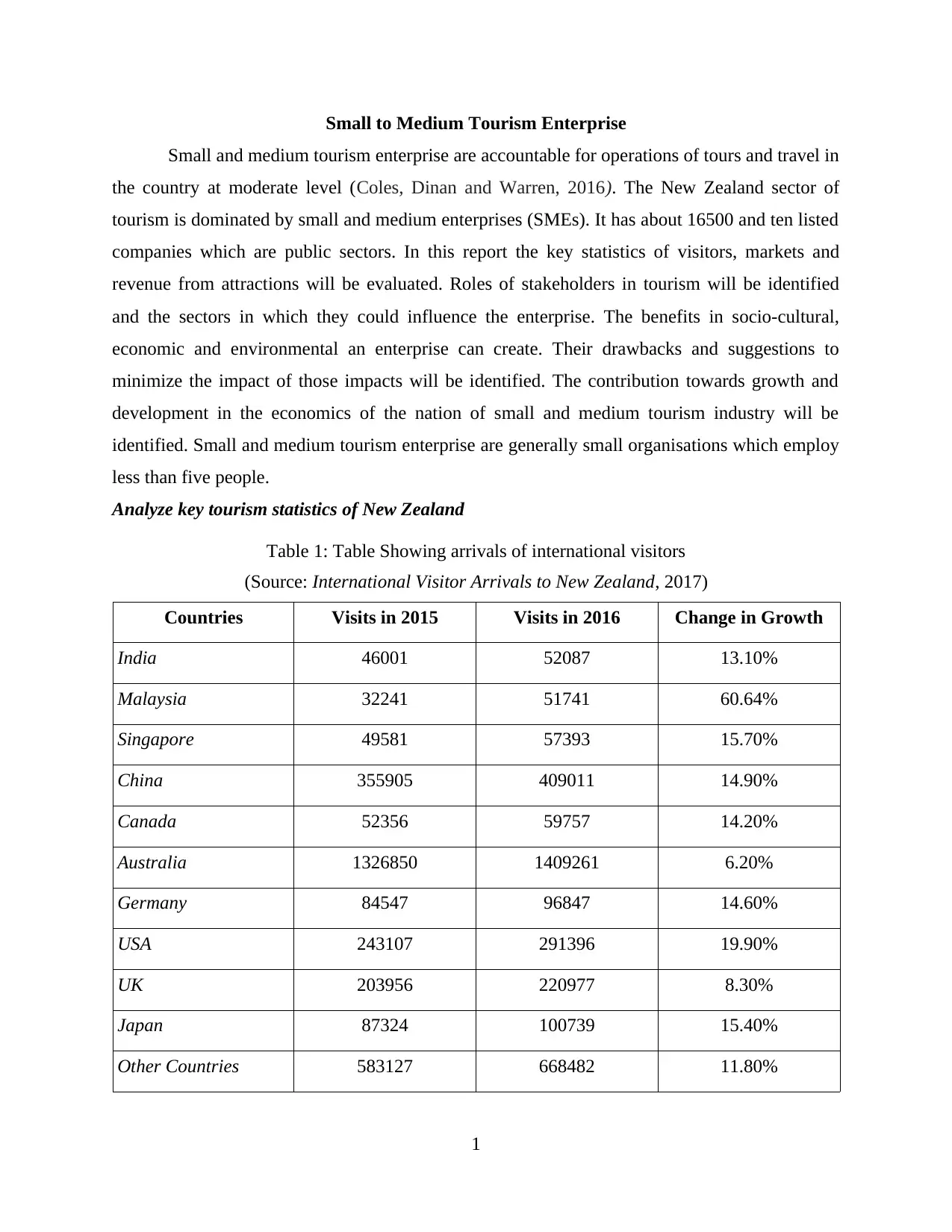
Small to Medium Tourism Enterprise
Small and medium tourism enterprise are accountable for operations of tours and travel in
the country at moderate level (Coles, Dinan and Warren, 2016). The New Zealand sector of
tourism is dominated by small and medium enterprises (SMEs). It has about 16500 and ten listed
companies which are public sectors. In this report the key statistics of visitors, markets and
revenue from attractions will be evaluated. Roles of stakeholders in tourism will be identified
and the sectors in which they could influence the enterprise. The benefits in socio-cultural,
economic and environmental an enterprise can create. Their drawbacks and suggestions to
minimize the impact of those impacts will be identified. The contribution towards growth and
development in the economics of the nation of small and medium tourism industry will be
identified. Small and medium tourism enterprise are generally small organisations which employ
less than five people.
Analyze key tourism statistics of New Zealand
Table 1: Table Showing arrivals of international visitors
(Source: International Visitor Arrivals to New Zealand, 2017)
Countries Visits in 2015 Visits in 2016 Change in Growth
India 46001 52087 13.10%
Malaysia 32241 51741 60.64%
Singapore 49581 57393 15.70%
China 355905 409011 14.90%
Canada 52356 59757 14.20%
Australia 1326850 1409261 6.20%
Germany 84547 96847 14.60%
USA 243107 291396 19.90%
UK 203956 220977 8.30%
Japan 87324 100739 15.40%
Other Countries 583127 668482 11.80%
1
Small and medium tourism enterprise are accountable for operations of tours and travel in
the country at moderate level (Coles, Dinan and Warren, 2016). The New Zealand sector of
tourism is dominated by small and medium enterprises (SMEs). It has about 16500 and ten listed
companies which are public sectors. In this report the key statistics of visitors, markets and
revenue from attractions will be evaluated. Roles of stakeholders in tourism will be identified
and the sectors in which they could influence the enterprise. The benefits in socio-cultural,
economic and environmental an enterprise can create. Their drawbacks and suggestions to
minimize the impact of those impacts will be identified. The contribution towards growth and
development in the economics of the nation of small and medium tourism industry will be
identified. Small and medium tourism enterprise are generally small organisations which employ
less than five people.
Analyze key tourism statistics of New Zealand
Table 1: Table Showing arrivals of international visitors
(Source: International Visitor Arrivals to New Zealand, 2017)
Countries Visits in 2015 Visits in 2016 Change in Growth
India 46001 52087 13.10%
Malaysia 32241 51741 60.64%
Singapore 49581 57393 15.70%
China 355905 409011 14.90%
Canada 52356 59757 14.20%
Australia 1326850 1409261 6.20%
Germany 84547 96847 14.60%
USA 243107 291396 19.90%
UK 203956 220977 8.30%
Japan 87324 100739 15.40%
Other Countries 583127 668482 11.80%
1

Black Sheep Touring Company operates as a small and medium tourism enterprise in New
Zealand. From the statistics provided in above table shows immense growth in visitors from all
the countries in the world (Worku, 2016). Tourism sectors directly contributes 9.0 billion NZ$ in
the country GDP and providing approximately 110800 employment which is nearly 6% of New
Zealand workforce.
Attractions and activities for visitors
Fiord-land National Park and Milford Sound, South Island The Fiord-land National Park consist of most mesmerising and beautiful landscapes in
the world, Black Sheep Touring company include the attractions in its package as visitors
enjoy and exploring glaciers, cascades, lakes, offshore islands, and mountains.
Auckland, North Island The largest city of New Zealand comprises various markets and amazing tourist spot.
Tourists visit here for its diverse market and adventurous sport like bungee jumping from
the 328 meter sky tower. It is also famous for rainforest, islands, picturesque coves and
volcanoes.
Fox and Franz Josef Glaciers, South Island Fox and Franz Josef Glaciers are among most reachable glaciers in the world. Visitors
purpose to visit is to explore the natural beauty and which is surrounded in the south
island of New Zealand. Ariel view facilities are provided to visitors by the tour operator
such as seaplane and helicopters so that they can get a different experience of the
beautiful place.
Coromandel Peninsula, North Island
The beautiful peninsula of northern island in New Zealand, which is the key attraction for
the visitors. Visitors enjoy hiking and birding as the peninsula provide excellent
opportunity to conduct the activities. Coromandel peninsula offers golden beach for the
relaxation of visitors. Many sea activities like sea diving, swimming, surfing etc are also
conducted. There are various art studios and a popular hot pool tub which impacts the
attraction of the site.
Black Sheep Touring company roles and responsibility is to provide responsible tour and
operations to the visitors. There are many types of stakeholders which can lay impact on the
2
Zealand. From the statistics provided in above table shows immense growth in visitors from all
the countries in the world (Worku, 2016). Tourism sectors directly contributes 9.0 billion NZ$ in
the country GDP and providing approximately 110800 employment which is nearly 6% of New
Zealand workforce.
Attractions and activities for visitors
Fiord-land National Park and Milford Sound, South Island The Fiord-land National Park consist of most mesmerising and beautiful landscapes in
the world, Black Sheep Touring company include the attractions in its package as visitors
enjoy and exploring glaciers, cascades, lakes, offshore islands, and mountains.
Auckland, North Island The largest city of New Zealand comprises various markets and amazing tourist spot.
Tourists visit here for its diverse market and adventurous sport like bungee jumping from
the 328 meter sky tower. It is also famous for rainforest, islands, picturesque coves and
volcanoes.
Fox and Franz Josef Glaciers, South Island Fox and Franz Josef Glaciers are among most reachable glaciers in the world. Visitors
purpose to visit is to explore the natural beauty and which is surrounded in the south
island of New Zealand. Ariel view facilities are provided to visitors by the tour operator
such as seaplane and helicopters so that they can get a different experience of the
beautiful place.
Coromandel Peninsula, North Island
The beautiful peninsula of northern island in New Zealand, which is the key attraction for
the visitors. Visitors enjoy hiking and birding as the peninsula provide excellent
opportunity to conduct the activities. Coromandel peninsula offers golden beach for the
relaxation of visitors. Many sea activities like sea diving, swimming, surfing etc are also
conducted. There are various art studios and a popular hot pool tub which impacts the
attraction of the site.
Black Sheep Touring company roles and responsibility is to provide responsible tour and
operations to the visitors. There are many types of stakeholders which can lay impact on the
2
⊘ This is a preview!⊘
Do you want full access?
Subscribe today to unlock all pages.

Trusted by 1+ million students worldwide
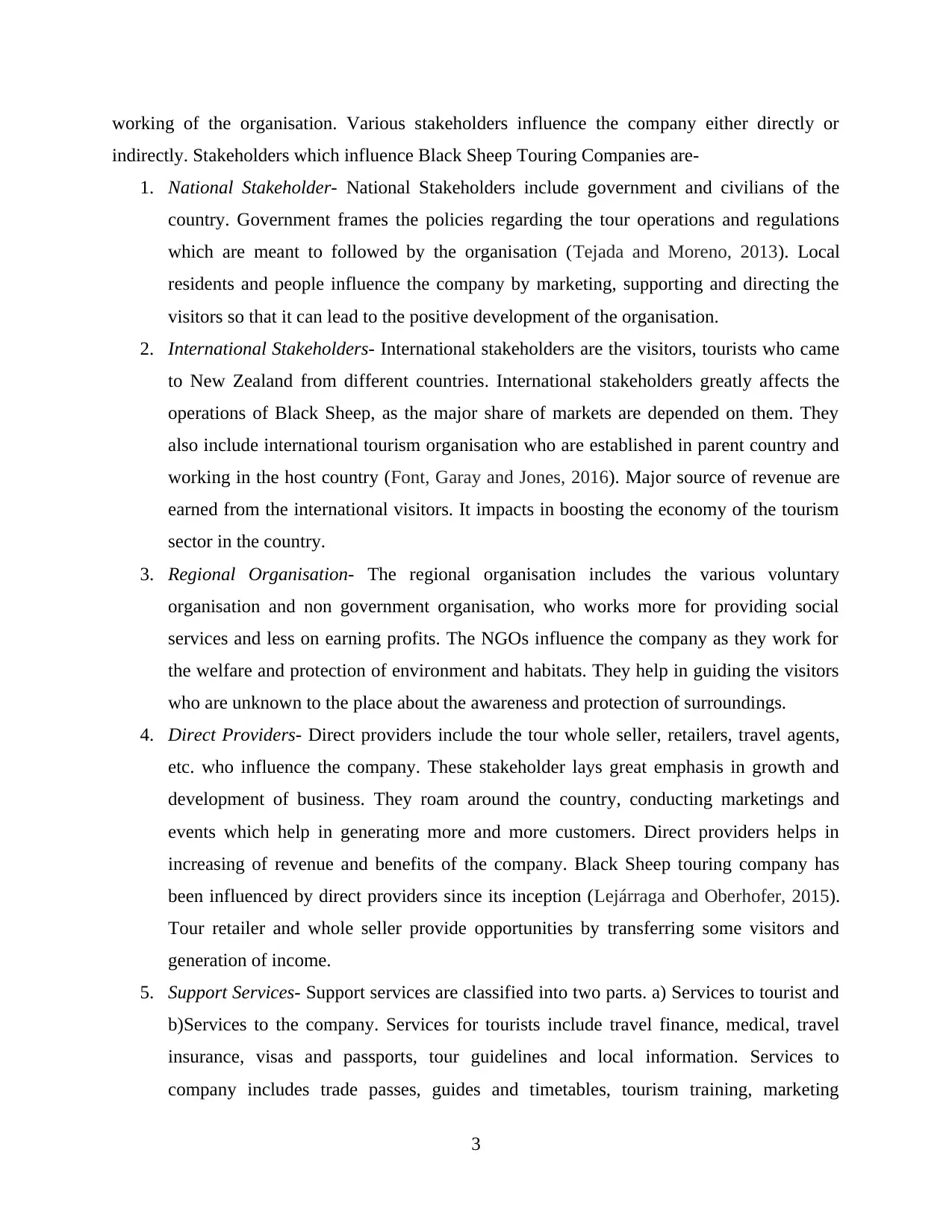
working of the organisation. Various stakeholders influence the company either directly or
indirectly. Stakeholders which influence Black Sheep Touring Companies are-
1. National Stakeholder- National Stakeholders include government and civilians of the
country. Government frames the policies regarding the tour operations and regulations
which are meant to followed by the organisation (Tejada and Moreno, 2013). Local
residents and people influence the company by marketing, supporting and directing the
visitors so that it can lead to the positive development of the organisation.
2. International Stakeholders- International stakeholders are the visitors, tourists who came
to New Zealand from different countries. International stakeholders greatly affects the
operations of Black Sheep, as the major share of markets are depended on them. They
also include international tourism organisation who are established in parent country and
working in the host country (Font, Garay and Jones, 2016). Major source of revenue are
earned from the international visitors. It impacts in boosting the economy of the tourism
sector in the country.
3. Regional Organisation- The regional organisation includes the various voluntary
organisation and non government organisation, who works more for providing social
services and less on earning profits. The NGOs influence the company as they work for
the welfare and protection of environment and habitats. They help in guiding the visitors
who are unknown to the place about the awareness and protection of surroundings.
4. Direct Providers- Direct providers include the tour whole seller, retailers, travel agents,
etc. who influence the company. These stakeholder lays great emphasis in growth and
development of business. They roam around the country, conducting marketings and
events which help in generating more and more customers. Direct providers helps in
increasing of revenue and benefits of the company. Black Sheep touring company has
been influenced by direct providers since its inception (Lejárraga and Oberhofer, 2015).
Tour retailer and whole seller provide opportunities by transferring some visitors and
generation of income.
5. Support Services- Support services are classified into two parts. a) Services to tourist and
b)Services to the company. Services for tourists include travel finance, medical, travel
insurance, visas and passports, tour guidelines and local information. Services to
company includes trade passes, guides and timetables, tourism training, marketing
3
indirectly. Stakeholders which influence Black Sheep Touring Companies are-
1. National Stakeholder- National Stakeholders include government and civilians of the
country. Government frames the policies regarding the tour operations and regulations
which are meant to followed by the organisation (Tejada and Moreno, 2013). Local
residents and people influence the company by marketing, supporting and directing the
visitors so that it can lead to the positive development of the organisation.
2. International Stakeholders- International stakeholders are the visitors, tourists who came
to New Zealand from different countries. International stakeholders greatly affects the
operations of Black Sheep, as the major share of markets are depended on them. They
also include international tourism organisation who are established in parent country and
working in the host country (Font, Garay and Jones, 2016). Major source of revenue are
earned from the international visitors. It impacts in boosting the economy of the tourism
sector in the country.
3. Regional Organisation- The regional organisation includes the various voluntary
organisation and non government organisation, who works more for providing social
services and less on earning profits. The NGOs influence the company as they work for
the welfare and protection of environment and habitats. They help in guiding the visitors
who are unknown to the place about the awareness and protection of surroundings.
4. Direct Providers- Direct providers include the tour whole seller, retailers, travel agents,
etc. who influence the company. These stakeholder lays great emphasis in growth and
development of business. They roam around the country, conducting marketings and
events which help in generating more and more customers. Direct providers helps in
increasing of revenue and benefits of the company. Black Sheep touring company has
been influenced by direct providers since its inception (Lejárraga and Oberhofer, 2015).
Tour retailer and whole seller provide opportunities by transferring some visitors and
generation of income.
5. Support Services- Support services are classified into two parts. a) Services to tourist and
b)Services to the company. Services for tourists include travel finance, medical, travel
insurance, visas and passports, tour guidelines and local information. Services to
company includes trade passes, guides and timetables, tourism training, marketing
3
Paraphrase This Document
Need a fresh take? Get an instant paraphrase of this document with our AI Paraphraser

supports, specialist financing, brochure distribution, etc. Support service greatly influence
the black sheep touring company by supporting and development in the growth of the
company (Lukianchuk, 2015). Tourists are satisfied with effective service provided by
the organisation. Eventually leads to the positive feedbacks and generation of more
customers.
6. Investors- Investors includes big companies, businessman or other equity firm who invest
in the organisation to earn profits and help in the invested organisation to increase its
businesses. Black Sheep has few investors including some private sector organisation
which help in the growth and development of the organisation. Investor influences the
company by helping them in funding (Coles, Dinan and Warren, 2016). Investors
carefully investigate about the organisation and then make decision on investment.
Economic, socio-cultural and environmental greatly impacts the working of small and medium
tourism enterprise in various ways. Economic environment include the market size, competitors,
employment rates, suppliers, retailers, etc. socio-cultural factors can be lifestyle and traditions
that define the society, customs and belief of the society, etc. and environmental factors include
the climate, geography, cultural, legal, and ecological factors that influence the operations of
touring business in different ways. Black Sheep as small and medium enterprise contributes in all
the factors which impacts the working of the organisation (Tejada and Moreno, 2013). There are
various benefits which are created by the enterprise in all the factors.
Economic benefits from touring business
1. Increasing growth in Economic of country- Small and medium tourism enterprise works
progressively towards the growth and development of the economy of New Zealand. The
direct contribution is approximately 3.9 % of total GDP which is 9.0 billion NZ$ in 2014.
By generating more revenue and providing diverse benefits, small and medium enterprise
helps in increasing growth and development of the country.
2. Reducing Unemployment rates- Small and medium tourism enterprise provides
employment to many people directly and indirectly. Unemployment is the biggest
problem any country faces (Font, Garay and Jones, 2016). Tourism enterprises help in
reducing the problem by providing employment. Approximately 6% of the total
workforce of New Zealand are employed and touring business enterprises and increasing
rapidly. Eventually helping in enhancing the economic benefits of country.
4
the black sheep touring company by supporting and development in the growth of the
company (Lukianchuk, 2015). Tourists are satisfied with effective service provided by
the organisation. Eventually leads to the positive feedbacks and generation of more
customers.
6. Investors- Investors includes big companies, businessman or other equity firm who invest
in the organisation to earn profits and help in the invested organisation to increase its
businesses. Black Sheep has few investors including some private sector organisation
which help in the growth and development of the organisation. Investor influences the
company by helping them in funding (Coles, Dinan and Warren, 2016). Investors
carefully investigate about the organisation and then make decision on investment.
Economic, socio-cultural and environmental greatly impacts the working of small and medium
tourism enterprise in various ways. Economic environment include the market size, competitors,
employment rates, suppliers, retailers, etc. socio-cultural factors can be lifestyle and traditions
that define the society, customs and belief of the society, etc. and environmental factors include
the climate, geography, cultural, legal, and ecological factors that influence the operations of
touring business in different ways. Black Sheep as small and medium enterprise contributes in all
the factors which impacts the working of the organisation (Tejada and Moreno, 2013). There are
various benefits which are created by the enterprise in all the factors.
Economic benefits from touring business
1. Increasing growth in Economic of country- Small and medium tourism enterprise works
progressively towards the growth and development of the economy of New Zealand. The
direct contribution is approximately 3.9 % of total GDP which is 9.0 billion NZ$ in 2014.
By generating more revenue and providing diverse benefits, small and medium enterprise
helps in increasing growth and development of the country.
2. Reducing Unemployment rates- Small and medium tourism enterprise provides
employment to many people directly and indirectly. Unemployment is the biggest
problem any country faces (Font, Garay and Jones, 2016). Tourism enterprises help in
reducing the problem by providing employment. Approximately 6% of the total
workforce of New Zealand are employed and touring business enterprises and increasing
rapidly. Eventually helping in enhancing the economic benefits of country.
4
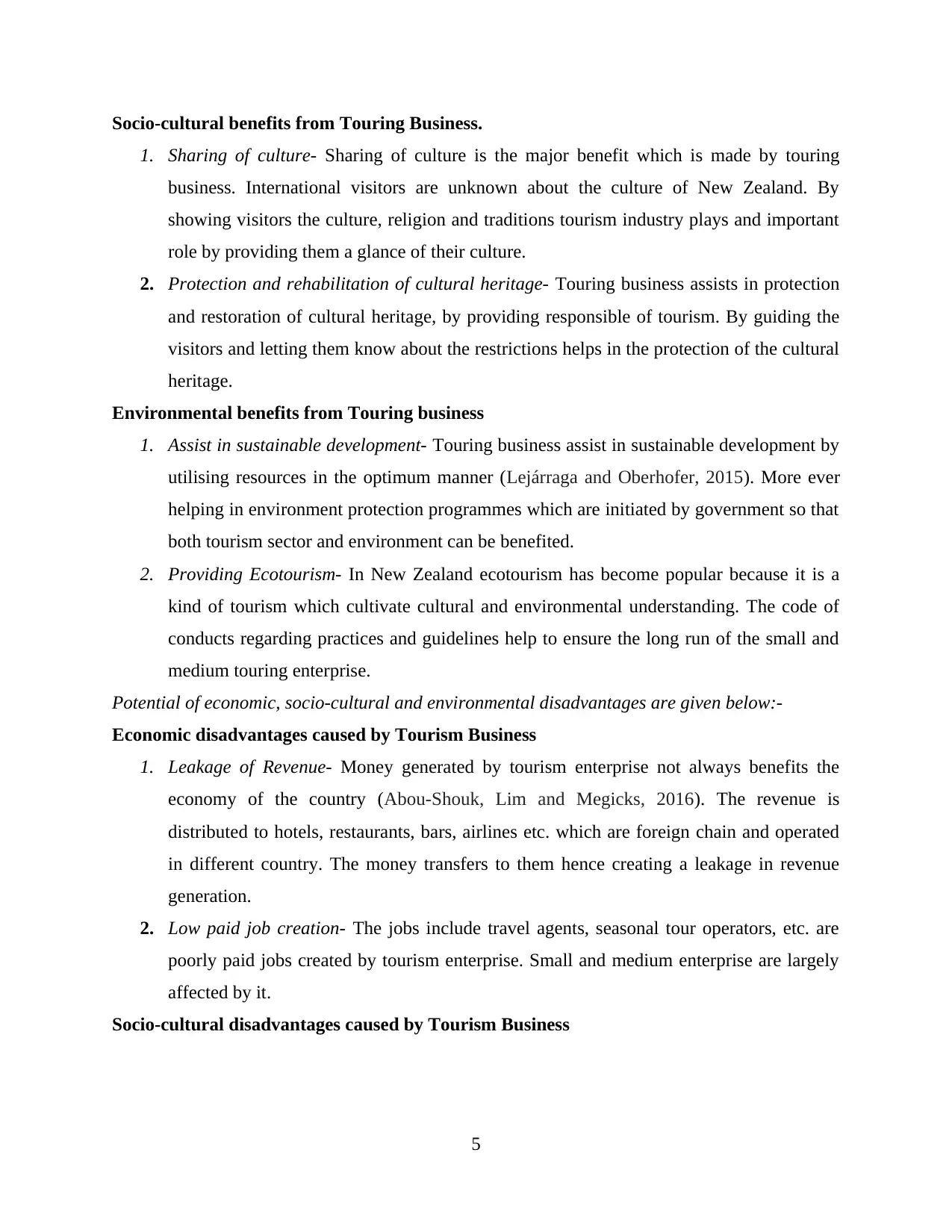
Socio-cultural benefits from Touring Business.
1. Sharing of culture- Sharing of culture is the major benefit which is made by touring
business. International visitors are unknown about the culture of New Zealand. By
showing visitors the culture, religion and traditions tourism industry plays and important
role by providing them a glance of their culture.
2. Protection and rehabilitation of cultural heritage- Touring business assists in protection
and restoration of cultural heritage, by providing responsible of tourism. By guiding the
visitors and letting them know about the restrictions helps in the protection of the cultural
heritage.
Environmental benefits from Touring business
1. Assist in sustainable development- Touring business assist in sustainable development by
utilising resources in the optimum manner (Lejárraga and Oberhofer, 2015). More ever
helping in environment protection programmes which are initiated by government so that
both tourism sector and environment can be benefited.
2. Providing Ecotourism- In New Zealand ecotourism has become popular because it is a
kind of tourism which cultivate cultural and environmental understanding. The code of
conducts regarding practices and guidelines help to ensure the long run of the small and
medium touring enterprise.
Potential of economic, socio-cultural and environmental disadvantages are given below:-
Economic disadvantages caused by Tourism Business
1. Leakage of Revenue- Money generated by tourism enterprise not always benefits the
economy of the country (Abou-Shouk, Lim and Megicks, 2016). The revenue is
distributed to hotels, restaurants, bars, airlines etc. which are foreign chain and operated
in different country. The money transfers to them hence creating a leakage in revenue
generation.
2. Low paid job creation- The jobs include travel agents, seasonal tour operators, etc. are
poorly paid jobs created by tourism enterprise. Small and medium enterprise are largely
affected by it.
Socio-cultural disadvantages caused by Tourism Business
5
1. Sharing of culture- Sharing of culture is the major benefit which is made by touring
business. International visitors are unknown about the culture of New Zealand. By
showing visitors the culture, religion and traditions tourism industry plays and important
role by providing them a glance of their culture.
2. Protection and rehabilitation of cultural heritage- Touring business assists in protection
and restoration of cultural heritage, by providing responsible of tourism. By guiding the
visitors and letting them know about the restrictions helps in the protection of the cultural
heritage.
Environmental benefits from Touring business
1. Assist in sustainable development- Touring business assist in sustainable development by
utilising resources in the optimum manner (Lejárraga and Oberhofer, 2015). More ever
helping in environment protection programmes which are initiated by government so that
both tourism sector and environment can be benefited.
2. Providing Ecotourism- In New Zealand ecotourism has become popular because it is a
kind of tourism which cultivate cultural and environmental understanding. The code of
conducts regarding practices and guidelines help to ensure the long run of the small and
medium touring enterprise.
Potential of economic, socio-cultural and environmental disadvantages are given below:-
Economic disadvantages caused by Tourism Business
1. Leakage of Revenue- Money generated by tourism enterprise not always benefits the
economy of the country (Abou-Shouk, Lim and Megicks, 2016). The revenue is
distributed to hotels, restaurants, bars, airlines etc. which are foreign chain and operated
in different country. The money transfers to them hence creating a leakage in revenue
generation.
2. Low paid job creation- The jobs include travel agents, seasonal tour operators, etc. are
poorly paid jobs created by tourism enterprise. Small and medium enterprise are largely
affected by it.
Socio-cultural disadvantages caused by Tourism Business
5
⊘ This is a preview!⊘
Do you want full access?
Subscribe today to unlock all pages.

Trusted by 1+ million students worldwide
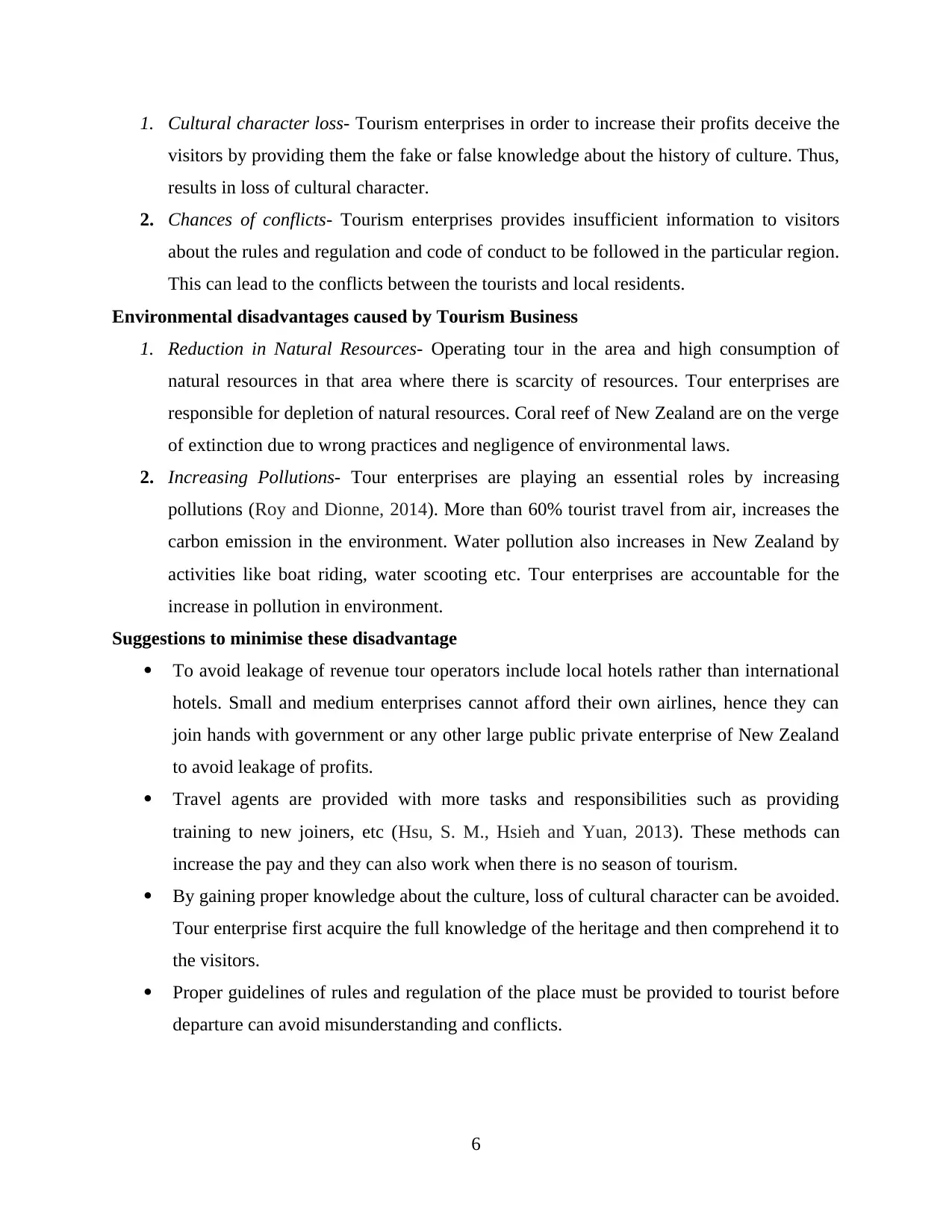
1. Cultural character loss- Tourism enterprises in order to increase their profits deceive the
visitors by providing them the fake or false knowledge about the history of culture. Thus,
results in loss of cultural character.
2. Chances of conflicts- Tourism enterprises provides insufficient information to visitors
about the rules and regulation and code of conduct to be followed in the particular region.
This can lead to the conflicts between the tourists and local residents.
Environmental disadvantages caused by Tourism Business
1. Reduction in Natural Resources- Operating tour in the area and high consumption of
natural resources in that area where there is scarcity of resources. Tour enterprises are
responsible for depletion of natural resources. Coral reef of New Zealand are on the verge
of extinction due to wrong practices and negligence of environmental laws.
2. Increasing Pollutions- Tour enterprises are playing an essential roles by increasing
pollutions (Roy and Dionne, 2014). More than 60% tourist travel from air, increases the
carbon emission in the environment. Water pollution also increases in New Zealand by
activities like boat riding, water scooting etc. Tour enterprises are accountable for the
increase in pollution in environment.
Suggestions to minimise these disadvantage
To avoid leakage of revenue tour operators include local hotels rather than international
hotels. Small and medium enterprises cannot afford their own airlines, hence they can
join hands with government or any other large public private enterprise of New Zealand
to avoid leakage of profits.
Travel agents are provided with more tasks and responsibilities such as providing
training to new joiners, etc (Hsu, S. M., Hsieh and Yuan, 2013). These methods can
increase the pay and they can also work when there is no season of tourism.
By gaining proper knowledge about the culture, loss of cultural character can be avoided.
Tour enterprise first acquire the full knowledge of the heritage and then comprehend it to
the visitors.
Proper guidelines of rules and regulation of the place must be provided to tourist before
departure can avoid misunderstanding and conflicts.
6
visitors by providing them the fake or false knowledge about the history of culture. Thus,
results in loss of cultural character.
2. Chances of conflicts- Tourism enterprises provides insufficient information to visitors
about the rules and regulation and code of conduct to be followed in the particular region.
This can lead to the conflicts between the tourists and local residents.
Environmental disadvantages caused by Tourism Business
1. Reduction in Natural Resources- Operating tour in the area and high consumption of
natural resources in that area where there is scarcity of resources. Tour enterprises are
responsible for depletion of natural resources. Coral reef of New Zealand are on the verge
of extinction due to wrong practices and negligence of environmental laws.
2. Increasing Pollutions- Tour enterprises are playing an essential roles by increasing
pollutions (Roy and Dionne, 2014). More than 60% tourist travel from air, increases the
carbon emission in the environment. Water pollution also increases in New Zealand by
activities like boat riding, water scooting etc. Tour enterprises are accountable for the
increase in pollution in environment.
Suggestions to minimise these disadvantage
To avoid leakage of revenue tour operators include local hotels rather than international
hotels. Small and medium enterprises cannot afford their own airlines, hence they can
join hands with government or any other large public private enterprise of New Zealand
to avoid leakage of profits.
Travel agents are provided with more tasks and responsibilities such as providing
training to new joiners, etc (Hsu, S. M., Hsieh and Yuan, 2013). These methods can
increase the pay and they can also work when there is no season of tourism.
By gaining proper knowledge about the culture, loss of cultural character can be avoided.
Tour enterprise first acquire the full knowledge of the heritage and then comprehend it to
the visitors.
Proper guidelines of rules and regulation of the place must be provided to tourist before
departure can avoid misunderstanding and conflicts.
6
Paraphrase This Document
Need a fresh take? Get an instant paraphrase of this document with our AI Paraphraser
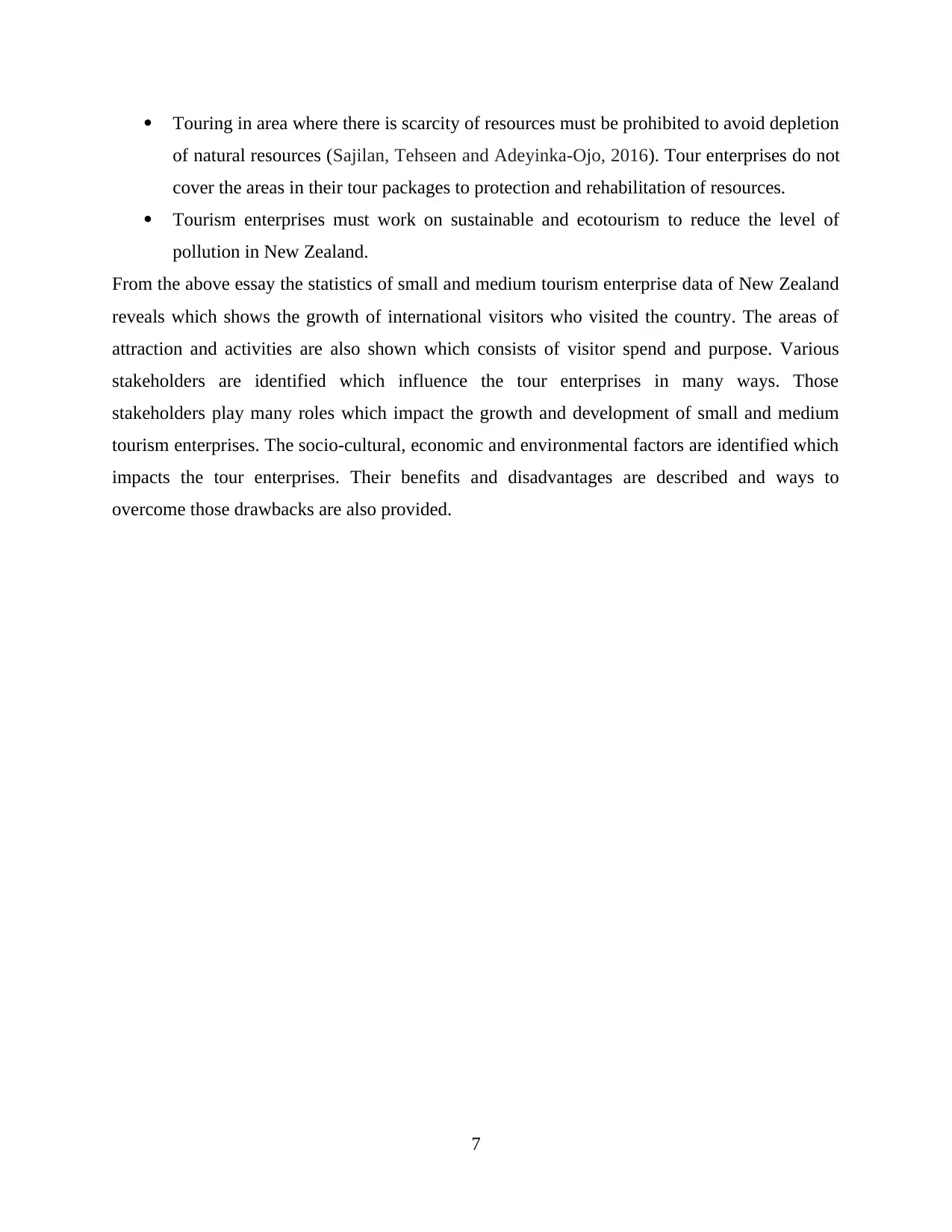
Touring in area where there is scarcity of resources must be prohibited to avoid depletion
of natural resources (Sajilan, Tehseen and Adeyinka-Ojo, 2016). Tour enterprises do not
cover the areas in their tour packages to protection and rehabilitation of resources.
Tourism enterprises must work on sustainable and ecotourism to reduce the level of
pollution in New Zealand.
From the above essay the statistics of small and medium tourism enterprise data of New Zealand
reveals which shows the growth of international visitors who visited the country. The areas of
attraction and activities are also shown which consists of visitor spend and purpose. Various
stakeholders are identified which influence the tour enterprises in many ways. Those
stakeholders play many roles which impact the growth and development of small and medium
tourism enterprises. The socio-cultural, economic and environmental factors are identified which
impacts the tour enterprises. Their benefits and disadvantages are described and ways to
overcome those drawbacks are also provided.
7
of natural resources (Sajilan, Tehseen and Adeyinka-Ojo, 2016). Tour enterprises do not
cover the areas in their tour packages to protection and rehabilitation of resources.
Tourism enterprises must work on sustainable and ecotourism to reduce the level of
pollution in New Zealand.
From the above essay the statistics of small and medium tourism enterprise data of New Zealand
reveals which shows the growth of international visitors who visited the country. The areas of
attraction and activities are also shown which consists of visitor spend and purpose. Various
stakeholders are identified which influence the tour enterprises in many ways. Those
stakeholders play many roles which impact the growth and development of small and medium
tourism enterprises. The socio-cultural, economic and environmental factors are identified which
impacts the tour enterprises. Their benefits and disadvantages are described and ways to
overcome those drawbacks are also provided.
7
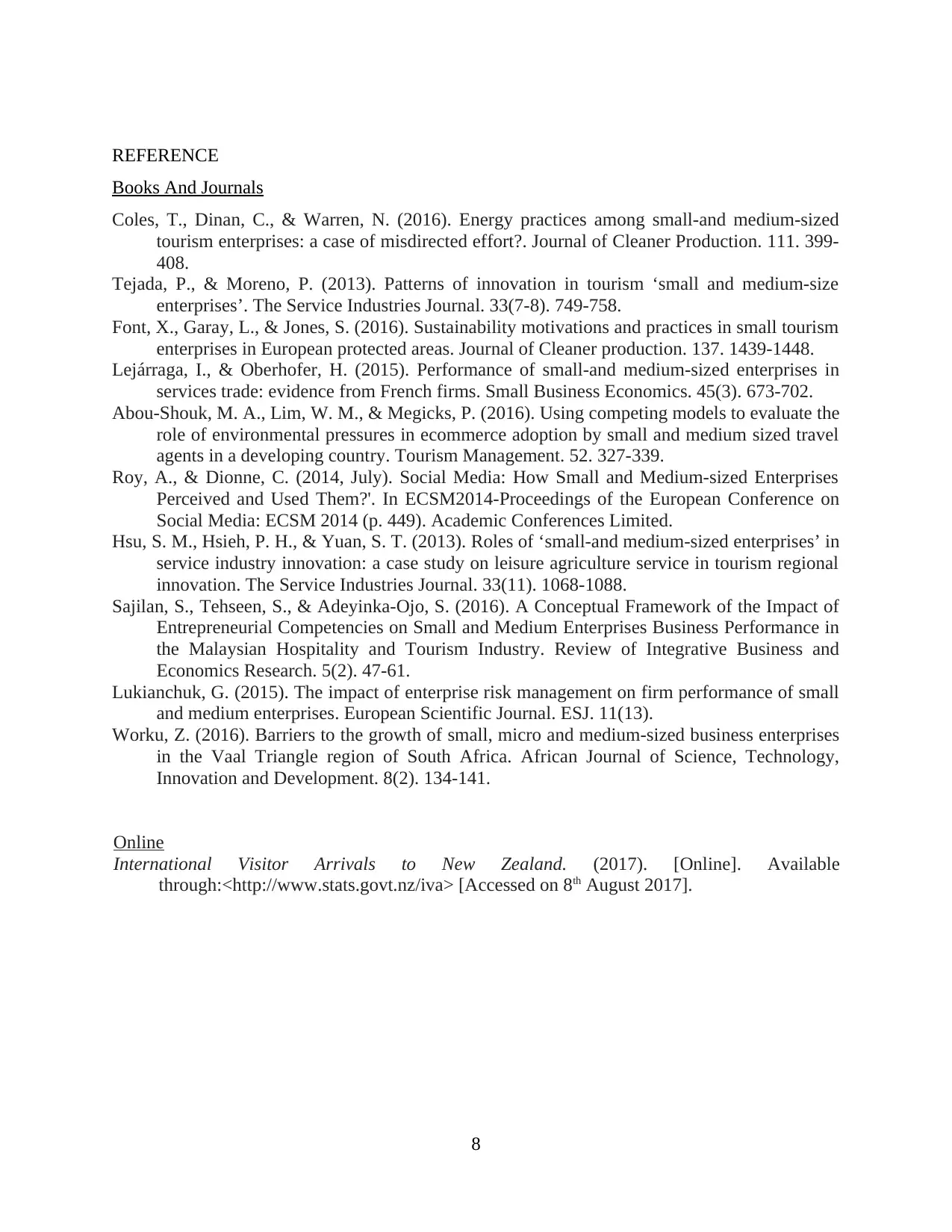
REFERENCE
Books And Journals
Coles, T., Dinan, C., & Warren, N. (2016). Energy practices among small-and medium-sized
tourism enterprises: a case of misdirected effort?. Journal of Cleaner Production. 111. 399-
408.
Tejada, P., & Moreno, P. (2013). Patterns of innovation in tourism ‘small and medium-size
enterprises’. The Service Industries Journal. 33(7-8). 749-758.
Font, X., Garay, L., & Jones, S. (2016). Sustainability motivations and practices in small tourism
enterprises in European protected areas. Journal of Cleaner production. 137. 1439-1448.
Lejárraga, I., & Oberhofer, H. (2015). Performance of small-and medium-sized enterprises in
services trade: evidence from French firms. Small Business Economics. 45(3). 673-702.
Abou-Shouk, M. A., Lim, W. M., & Megicks, P. (2016). Using competing models to evaluate the
role of environmental pressures in ecommerce adoption by small and medium sized travel
agents in a developing country. Tourism Management. 52. 327-339.
Roy, A., & Dionne, C. (2014, July). Social Media: How Small and Medium-sized Enterprises
Perceived and Used Them?'. In ECSM2014-Proceedings of the European Conference on
Social Media: ECSM 2014 (p. 449). Academic Conferences Limited.
Hsu, S. M., Hsieh, P. H., & Yuan, S. T. (2013). Roles of ‘small-and medium-sized enterprises’ in
service industry innovation: a case study on leisure agriculture service in tourism regional
innovation. The Service Industries Journal. 33(11). 1068-1088.
Sajilan, S., Tehseen, S., & Adeyinka-Ojo, S. (2016). A Conceptual Framework of the Impact of
Entrepreneurial Competencies on Small and Medium Enterprises Business Performance in
the Malaysian Hospitality and Tourism Industry. Review of Integrative Business and
Economics Research. 5(2). 47-61.
Lukianchuk, G. (2015). The impact of enterprise risk management on firm performance of small
and medium enterprises. European Scientific Journal. ESJ. 11(13).
Worku, Z. (2016). Barriers to the growth of small, micro and medium-sized business enterprises
in the Vaal Triangle region of South Africa. African Journal of Science, Technology,
Innovation and Development. 8(2). 134-141.
Online
International Visitor Arrivals to New Zealand. (2017). [Online]. Available
through:<http://www.stats.govt.nz/iva> [Accessed on 8th August 2017].
8
Books And Journals
Coles, T., Dinan, C., & Warren, N. (2016). Energy practices among small-and medium-sized
tourism enterprises: a case of misdirected effort?. Journal of Cleaner Production. 111. 399-
408.
Tejada, P., & Moreno, P. (2013). Patterns of innovation in tourism ‘small and medium-size
enterprises’. The Service Industries Journal. 33(7-8). 749-758.
Font, X., Garay, L., & Jones, S. (2016). Sustainability motivations and practices in small tourism
enterprises in European protected areas. Journal of Cleaner production. 137. 1439-1448.
Lejárraga, I., & Oberhofer, H. (2015). Performance of small-and medium-sized enterprises in
services trade: evidence from French firms. Small Business Economics. 45(3). 673-702.
Abou-Shouk, M. A., Lim, W. M., & Megicks, P. (2016). Using competing models to evaluate the
role of environmental pressures in ecommerce adoption by small and medium sized travel
agents in a developing country. Tourism Management. 52. 327-339.
Roy, A., & Dionne, C. (2014, July). Social Media: How Small and Medium-sized Enterprises
Perceived and Used Them?'. In ECSM2014-Proceedings of the European Conference on
Social Media: ECSM 2014 (p. 449). Academic Conferences Limited.
Hsu, S. M., Hsieh, P. H., & Yuan, S. T. (2013). Roles of ‘small-and medium-sized enterprises’ in
service industry innovation: a case study on leisure agriculture service in tourism regional
innovation. The Service Industries Journal. 33(11). 1068-1088.
Sajilan, S., Tehseen, S., & Adeyinka-Ojo, S. (2016). A Conceptual Framework of the Impact of
Entrepreneurial Competencies on Small and Medium Enterprises Business Performance in
the Malaysian Hospitality and Tourism Industry. Review of Integrative Business and
Economics Research. 5(2). 47-61.
Lukianchuk, G. (2015). The impact of enterprise risk management on firm performance of small
and medium enterprises. European Scientific Journal. ESJ. 11(13).
Worku, Z. (2016). Barriers to the growth of small, micro and medium-sized business enterprises
in the Vaal Triangle region of South Africa. African Journal of Science, Technology,
Innovation and Development. 8(2). 134-141.
Online
International Visitor Arrivals to New Zealand. (2017). [Online]. Available
through:<http://www.stats.govt.nz/iva> [Accessed on 8th August 2017].
8
⊘ This is a preview!⊘
Do you want full access?
Subscribe today to unlock all pages.

Trusted by 1+ million students worldwide

9
1 out of 10
Related Documents
Your All-in-One AI-Powered Toolkit for Academic Success.
+13062052269
info@desklib.com
Available 24*7 on WhatsApp / Email
![[object Object]](/_next/static/media/star-bottom.7253800d.svg)
Unlock your academic potential
Copyright © 2020–2025 A2Z Services. All Rights Reserved. Developed and managed by ZUCOL.



